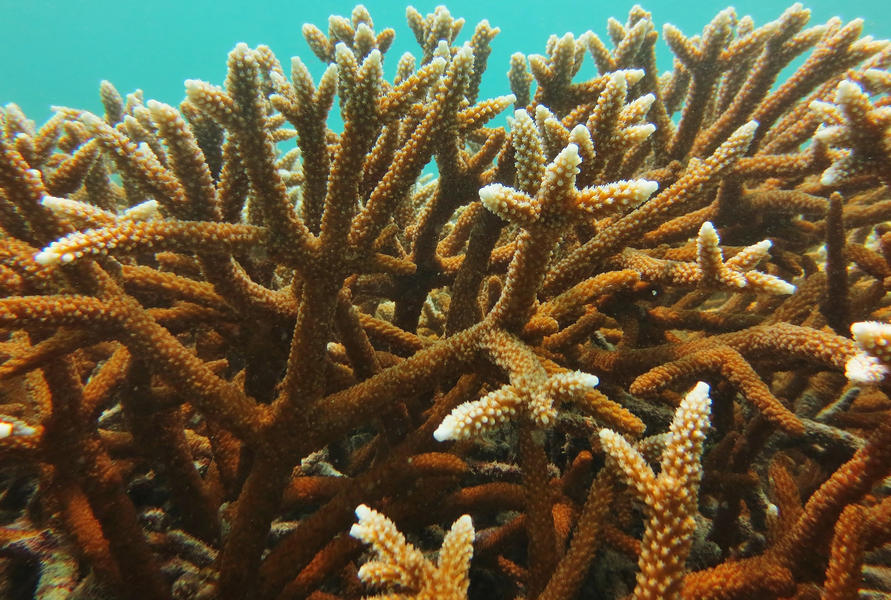Author Name
Michael S. Studivan, Ashley Rossin, Sophia Ippolito, Mark Ladd, Dan M. Holstein, Andrew C. Baker, Ian C. Enochs
Florida’s Coral Reef has experienced severe declines due to disease outbreaks, thermal stress, and degraded water quality, with notable recent impacts from stony coral tissue loss disease (SCTLD) and the 2023 marine heatwave. This project investigated the restoration potential of "urban corals"—those persisting in highly urbanized environments such as the Port of Miami, as a potential means to aid in the recovery of Florida’s Coral Reef. Studied since 2018, these corals have shown resilience to environmental stressors that have devastated reef populations, and therefore serve as valuable genotypes for restoration initiatives.
The study focused on three primary objectives: 1) identifying spawning windows of urban coral populations, 2) quantifying their reproductive capability and gamete viability, and 3) incorporating urban genotypes into land-based propagation and restoration pipelines at the University of Miami’s Cooperative Institute for Marine and Atmospheric Studies (CIMAS), NOAA’s Southeast Fisheries Science Center (SEFSC), the University of Miami’s Rosenstiel School, the Florida Fish and Wildlife Conservation Commission (FWC), and Nova Southeastern University (NSU). Field-based monitoring efforts consisted of 17 total field days across summer 2024 and spring 2025 spawning seasons in the Port of Miami and Port of Palm Beach, tenting of 40 colonies of the species Colpophyllia natans, Diploria labyrinthiformis, Orbicella faveolata, and Pseudodiploria strigosa with gamete collection tents, extended observation of 22 colonies of the same species with time lapse cameras, and sampling of 67 colonies of the same species but also including P. clivosa, before and after their respective spawning seasons (127 samples total) for fecundity analysis. No spawning was observed in the wild, likely due to asynchronous timing driven by environmental factors such as artificial light pollution. However, fecundity analysis revealed that urban corals are reproductively viable and produce gametes comparable in size and fecundity to reef corals, and post-spawning sampling shows these corals released gametes during the predicted spawning season. Transfer of 29 corals of opportunity (COOs) to a land-based aquaculture system also did not result in observed spawning activity, with the exception of one urban D. labyrinthiformis colony that released gamete bundles 11 days after the full moon (AFM) on April 23, 2025. Despite over 2 hours in time delay between urban and reef corals spawning, we conducted an urban x reef parental cross with a Miami reef conspecific, resulting in successful fertilization and settlement of approximately 2,676 surviving recruits. This novel finding demonstrates the potential for integration of urban corals into sexual reproduction programs.
Efforts to propagate urban corals through conventional asexual fragmentation practices faced challenges, particularly low survivorship due to ciliate infections. It is likely that factors unique to their native habitats, such as pre-existing stress from sedimentation and burial, as well as the potential for harmful microbes being transferred with the corals, heavily impacted their survival in a land-based system. Nevertheless, several urban coral genotypes were preserved and transferred to multiple facilities across Florida, expanding the network of live gene banks and restoration partners. This work will continue in FY26 through additional support from FDEP, and is expected to further expand the network of urban coral gene banking and land-based sexual reproduction with partners at the Reef Institute and Mote Marine Laboratory.
These findings underscore the ecological importance of urban coral populations and support their inclusion in conservation and restoration strategies. Despite existing challenges, urban corals offer a promising source of resilient genotypes. Continued research and targeted conservation of these corals are essential, particularly as urban development intensifies along Florida’s coastlines. Ultimately, these efforts will improve restoration success, efficiency, and cost-effectiveness in the recovery of Florida’s Coral Reef


